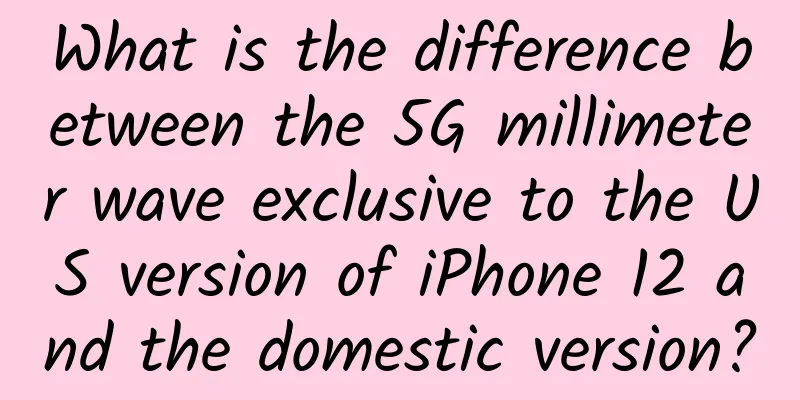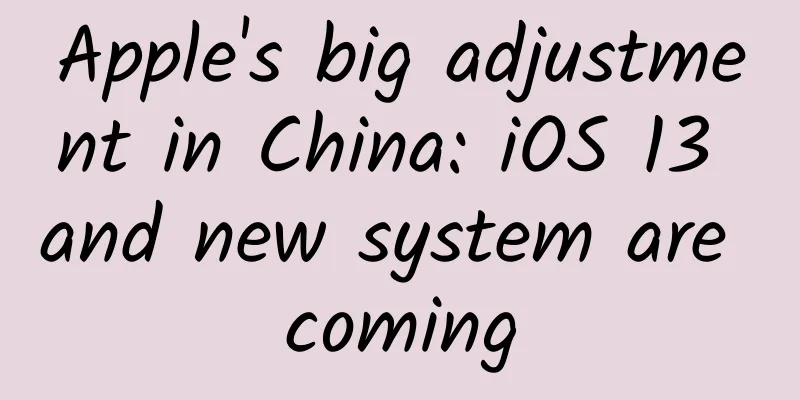What is the difference between the 5G millimeter wave exclusive to the US version of iPhone 12 and the domestic version?

|
This year's iPhone 12 has returned to the old days of paying extra to get the product. Users who were holding back last year because the iPhone 11 did not have 5G finally have a reason to change their phones. At the press conference, Apple also introduced 5G as the most important highlight. The iPhone 12 supports almost all current 5G frequency bands, surpassing mainstream Android models, but only the US version supports millimeter wave bands. Some netizens are therefore wondering whether the domestic version that does not support millimeter waves is a castrated version of the iPhone 12? The answer is no. This will not affect domestic users' use of 5G on the iPhone 12, and the domestic 5G network does not support millimeter waves. However, there are indeed differences in the 5G experience between the iPhone 12 that supports millimeter wave and the Chinese version that uses low-frequency sub-6GHz. Today, let's talk about the topic of 5G millimeter wave. This article attempts to clarify several issues:
The millimeter wave exclusive to the US version of the iPhone 12 and the sub-6GHz supported by the Chinese version are actually the two major branches of the current global 5G network frequency bands. As the name implies, the frequency wavelength of millimeter waves is less than 10 mm, and generally refers to the frequency band above 24 GHz. Sub-6 GHz is the network frequency band below 6 GHz, and because the wavelength is at the centimeter level, it is also called "centimeter wave". Millimeter wave and centimeter wave, judging from the names, millimeter wave seems to win, just like in navigation satellites, millimeter-level positioning is obviously more accurate than centimeter-level positioning, so is 5G millimeter wave more powerful than sub-6GH? Indeed, millimeter waves have advantages that sub-6GHz cannot match, which can be reflected in the most intuitive network speed. According to the measured data from the network speed test platform Ookla, the download speed of 5G millimeter wave terminals is four times that of the frequency band below 6GHz, with an average rate of 900 Mbps and a peak rate of more than 2Gbps. At last month's press conference, Apple said that the iPhone 12 can achieve a peak downlink rate of up to 4Gbps, also referring to millimeter waves. Currently, domestic packages under 200 yuan provide a maximum of 60G of traffic, which can be used up in 2 minutes at this rate. Of course, this is a theoretical peak value, which is generally not achieved in actual use. In SpeedSmart's 5G network test of the iPhone 12, the Verizon iPhone 12 using millimeter wave 5G has significantly higher download and upload speeds than the iPhone 12 using sub-6GHz. Since millimeter waves are so strong, is it more cost-effective to buy a US version of iPhone 12? Don’t worry, although millimeter wave can easily crush sub-6GHz in terms of network speed, it has a fatal flaw: large signal attenuation and small coverage range. According to common sense in physics, the higher the frequency of electromagnetic waves, the shorter the wavelength, the shorter the transmission distance, and the longer the signal attenuation when passing through obstacles. For example, the signal attenuation in the 28GHz frequency band is 1600 times higher than that in the 700MHz band. Therefore, 5G mobile phones using millimeter waves may have their signals blocked by anything. Trees, rain and fog can block more than half of the signals. Even the human body's loss of millimeter waves can reach 11~28dB, which can reproduce the "death grip" of the iPhone 4, not to mention penetrating walls. Although there are many technical solutions to solve the problems of millimeter wave signal attenuation and blocking, their performance in commercial use is still not ideal. Google has tested 5G coverage in the United States with the same range and the same number of base stations. The results show that a 5G network deployed with millimeter waves can cover 11.6% of the population at a rate of 100Mbps and 3.9% of the population at a rate of 1Gbps. Using sub-6GHz 5G networks, 57.4% of the population can be covered at a rate of 100Mbps, and 21.2% of the population at a rate of 1Gbps. Precisely because of the high loss of millimeter-wave signals, traditional antennas cannot be used when integrated into mobile phones. More antennas need to be installed, and higher requirements are still placed on baseband digital processing capabilities. The "patch" on the side of the US version of the iPhone 12 is the millimeter-wave antenna module. More complex manufacturing processes bring higher costs. According to Ming-Chi Kuo, the Sub-6 and millimeter wave 5G components used in the iPhone 12 series cost $75-85 and $125-135 respectively. In addition, it was recently revealed that the iPhone 12 consumes power very quickly under 5G state, which is also related to the antenna design of the 5G mobile phone. 5G terminals generally use Massive MIMO (massive multiple-input, multiple-output) antenna technology to improve network transmission efficiency and compensate for signal attenuation. Millimeter wave commercialization is even more inseparable from this technology. However, Massive MIMO technology reduces transmission power consumption at the expense of higher computing costs. Mobile phones need to integrate more antennas. Multiple antennas simultaneously sending (multiple outputs) and receiving signals (multiple inputs) means higher power consumption and naturally more power consumption. Simply put, millimeter wave is like a sprinter, with strong explosive power but limited distance. Sub-6GHz is like a long-distance runner, running slower but farther, and its own advantages happen to be the disadvantages of the other. Although Qualcomm implied last year that Huawei's 5G does not support millimeter waves and is not real 5G, this is actually just a propaganda method for both parties in the 5G route dispute. Millimeter waves and sub-6GHz are actually not in conflict. On the contrary, they will provide 5G services in a collaborative networking manner for a long time in the future. Why does the United States use millimeter waves but China doesn't? As mentioned above, the commercial use of 5G millimeter waves faces many problems. So why does the United States want to deploy 5G networks based on millimeter waves? Don’t American operators know the shortcomings of millimeter waves?
In fact, American operators also want to use the low-frequency sub-6GHz, but most of this frequency band has been used for military communications and defense communications. Even if it is to be freed up for commercial use, it will take some time to clear the frequency band. In this context, operators can only bet on millimeter waves. Among them, Verizon, which provides 5G millimeter wave services for iPhone 12, is also the world's earliest operator to commercialize 5G services. As early as 2018, it provided 5G services in 4 cities in the United States and stated that "millimeter wave spectrum is the cornerstone of realizing 5G ultra-wideband networks." However, due to the fact that 5G millimeter wave supporting technologies are not yet fully mature, the popularity of 5G in the United States is relatively slow. According to data from M-Science, a subsidiary of Wall Street investment bank Jefferies, as of mid-July 2020, the number of 5G users in the United States was 4.082 million, less than half of the number of 5G users in South Korea. Globally, most operators have adopted Sub-6G as their 5G networking solution. According to a report by S&P Global Ratings, as of September this year, only 12% of the 113 operators that have been commercially available in 52 markets around the world use millimeter wave frequency bands.
Obviously, before millimeter wave completely solves the problems of signal attenuation and coverage, sub-6GHz is the effective solution to make 5G cover a wider range in the short term. In fact, the United States has also realized this problem and started to deploy sub-6GHz 5G networks. Not long ago, the United States auctioned 100MHz mid-band spectrum originally used for military purposes to operators, and plans to put it into commercial use in mid-2022.
The report “5G Ecosystem: Risks and Opportunities for the U.S. Department of Defense” released by the Defense Innovation Board of the U.S. Department of Defense also pointed out: Due to propagation and cost limitations, millimeter waves cannot be deployed on a large scale in the United States at this stage. Sub-6 GHz mid-band spectrum (in the 3 GHz and 4 GHz range) will become the global standard for wide area networks in the next few years. Chinese operators are much happier. my country has relatively abundant resources in the Sub-6 frequency band and can allocate 100 MHz or more continuous test frequencies to several major operators. Foreign operators mostly rely on auctions to acquire frequency bands, and the prices are often in the hundreds of millions. For example, last year Deutsche Telekom spent nearly 2.2 billion euros (about 17.2 billion yuan) to acquire 40MHz spectrum in the 2GHz band. Although China does not need to rush to use millimeter waves due to frequency band resources, it is also actively researching and deploying millimeter waves. Because millimeter waves, which seem a bit useless now, are the real future of 5G. 5G without millimeter wave is indeed incomplete In the video about 5G that made B station UP host He Tongxue famous, he said that speed is actually the most boring application of 5G. At present, our perception of 5G is mainly that the network speed is faster. This is because 5G still lacks killer applications. Some netizens even joked that the killer application of 5G network today is speed test software. In fact, among the three major application scenarios of 5G, in addition to enhanced mobile broadband (eMBB) that improves network speed, there are also massive machine type communication (mMTC) and ultra-reliable low latency communication (URLLC). To realize the latter two 5G application scenarios, millimeter wave is indispensable. For example, massive machine type communications (mMTC) requires the device connection density to reach 1 million devices per square kilometer, so that even in crowded subways and stadiums, everyone's device can access the Internet smoothly. This requires the advantages of 5G millimeter wave technology, such as large bandwidth, high instantaneous rate, and large system capacity, to be achieved. This is also true for application scenarios that require low latency, such as AR/VR, cloud gaming, and industrial robots. The air interface time slot length of the 5G millimeter wave system can be as short as 0.125ms, which is only a quarter of the current mainstream 5G medium and low frequency systems. As the Global System for Mobile Communications Association (GSMA) mentioned in the "5G Millimeter Wave Technology White Paper", 5G millimeter wave is the inevitable direction of the evolution of mobile communication technology, and millimeter wave can fully unleash the full potential of 5G. The technology for improving 5G millimeter wave coverage is becoming increasingly mature. In addition to the Massive MIMO mentioned above, beamforming technology is also a commonly used solution. The difference between a traditional 4G base station and a 5G base station using beamforming is like the difference between a light bulb and a flashlight. The signals emitted by 4G base stations are all divergent like light bulbs, while beamforming can aim the radio waves at the terminals that need mobile networks, just like a flashlight shining the light beam at the target and moving with the target, which can greatly increase the communication distance of millimeter waves. In addition, millimeter waves can deploy a large number of small base stations to ensure high peak throughput by reducing the communication distance, thereby improving coverage. This is lower cost than the tower-sized macro base stations used in 5G medium and low frequencies.
With the support of a series of technologies, millimeter wave propagation in outdoor line-of-sight can now reach 1-2 kilometers, while the non-line-of-sight coverage distance is between 100-200 meters. In September, Qualcomm, Ericsson and Casa Systems jointly expanded the communication range of millimeter waves to 3.8 kilometers, which is also the longest transmission distance of millimeter waves at present. Xu Hao, head of R&D for Qualcomm China, once said that only with millimeter wave capabilities can 5G be complete, and the deployment of 5G millimeter wave is an important step in realizing the entire 5G vision. The above technologies bring 5G, which will truly change our lives, one step closer. When will China use 5G millimeter wave? Although China's 5G was only officially commercialized in June last year, according to data from the Ministry of Industry and Information Technology, as of the end of September, the total number of 5G base stations put into operation nationwide has exceeded 690,000, and China's 5G users have exceeded 150 million.
Currently, there are more than 800,000 5G base stations deployed worldwide, and the total number of 5G users worldwide is less than 200 million. It can be seen that China is already in a leading position in the progress of 5G construction. As 5G continues to become more popular, China's millimeter wave applications have also been put on the agenda. According to the plan of China's IMT-2020 (5G) Promotion Group, 5G millimeter wave will be promoted in three stages:
At the 2022 Beijing Winter Olympics, China Unicom will adopt a networking solution based on 5G millimeter wave technology to provide network services for the Winter Olympics venues. In addition to operators, hardware manufacturers are also preparing for the commercial use of millimeter waves. The millimeter wave customized version of OnePlus 8 became China's first smartphone to support 5G millimeter waves. Huawei Mate X also has a millimeter wave version, but it has not been sold to the public.
As for the relevant industrial chain, Chi Yongsheng, deputy director of China Unicom Network Technology Research Institute, pointed out that the domestic millimeter wave industrial chain is still relatively weak compared with that of foreign countries, and the degree of localization of core technologies and core components is relatively low. However, China has also made breakthroughs in 5G millimeter wave chips. The millimeter wave chip developed by Nanjing Purple Mountain Laboratory of Network Communications and Security has reduced the cost per channel from 1,000 yuan to 20 yuan, and is expected to be commercially available in 2022. Not only in China, more than 120 operators around the world have invested in the research and development of millimeter waves. They are eyeing the huge application prospects and considerable commercial potential of 5G millimeter waves. According to GSMA's forecast, the contribution of millimeter wave 5G to global GDP will grow exponentially from 2020 to 2034, and will contribute US$565 billion to global GDP and US$152 billion in tax revenue in 2034. By then, when people mention 5G, they may no longer think of mobile phones, and there may even be devices that can replace smartphones. |
<<: WeChat red envelope cover upgrade: individuals can also customize
>>: In the era of isolation, how can facial and fingerprint recognition “previous to failure”?
Recommend
Hupu APP Product Analysis Report
This article conducts product experience and anal...
How to rent a server cabinet?
How to rent a server cabinet? The rental of a ser...
The Ministry of Foreign Affairs responded to the Australian Prime Minister's statement that he welcomes China's rise (full text)
The Ministry of Foreign Affairs responded to the ...
Essential for increasing followers: Learn the fission promotion methodology in 5 minutes!
Written in front I personally participated in a c...
"SARFT's game approval authority has been cancelled" is a misunderstanding of the policy
On August 13, the State Council announced a new b...
Don’t be a “cold person”! How to keep your hands and feet warm in winter? | There is great science in life
Although this winter is likely to be a warm one, ...
Red Planet's "Introduction to Short Videos in Physical Stores" - How to shoot and edit ideas, Dou+ delivery, etc.
Course Contents: Introduction to short videos in ...
Exclusive interview with Udesk CTO Xiao Lipeng: Enterprise-level customer service system architecture under the cloud platform
[[152876]] With the development of mobile Interne...
Meituan APP product analysis report: Strengthen guidance on user decision-making!
1. Introduction 1. Background 2. Experience the e...
These 6 high-tech mobile phone apps will instantly improve the quality of your phone!
After using mobile phones for such a long time, I...
The anxiety of the automotive industry: disputes over various routes for new energy vehicles
The global automotive industry is quite anxious d...
Apple's event takes place this week: What to expect this year
The highly anticipated Apple conference will be h...
CBC rule of holiday marketing: How to follow the hot topics of Mother’s Day and Children’s Day?
"Every time a festival comes, copywriters wo...
China Automobile Dealers Association: Automobile production fell 7% and consumption fell 10% in May 2022
According to data from the National Bureau of Sta...
I accidentally ate this fruit and my mouth swelled up like a sausage!
Review expert: Shi Jun, Ph.D. in botany, well-kno...









